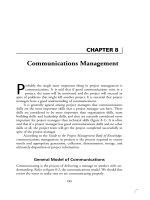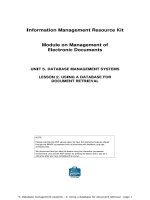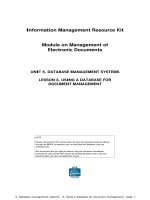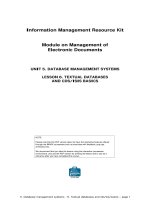Lecture Database management systems Chapter 8 SQL
Bạn đang xem bản rút gọn của tài liệu. Xem và tải ngay bản đầy đủ của tài liệu tại đây (781.75 KB, 41 trang )
SQL
7/11/2011
1
Introduction
SQL commands can be classified in to three types:
Data Definition Language commands (DDL)
Data Manipulation Language commands (DML)
Data Control Language commands (DCL)
7/11/2011
2
Domain types
Numeric:
int. Integer (a finite subset of the integers that is
machine-dependent).
smallint.
Small integer (a machine-dependent
subset of the integer domain type).
numeric(p,d).
Fixed point number, with userspecified precision of p digits, with n digits to the
right of decimal point.
real, double precision. Floating point and doubleprecision floating point numbers, with machinedependent precision.
float(n). Floating point number, with user-specified
precision of at least n digits.
7/11/2011
3
Domain types
String:
char(n). Fixed length character string, with
user-specified length n.
varchar(n).
Variable length character
strings, with user-specified maximum length n
nvarchar(n). similar to varchar, except it
uses Unicode and therefore doubles the
amount of space required to store the data.
Text: holds data that is longer than 8,000
characters
7/11/2011
4
Domain types
Datetime:
datetime. store not only a date, but also a
time alongside it.
smalldatetime.
7/11/2011
5
Create Table Construct
An SQL relation is defined using the create table command:
create table r
(A1 D1, A2 D2, ..., An Dn,
(integrity-constraint1),
...,
(integrity-constraintk))
r is the name of the relation
each Ai is an attribute name in the schema of relation r
Di is the data type of values in the domain of attribute Ai
7/11/2011
6
Create Table Construct
department (dept_no, dept_name, location)
Primary key: dept_no
Candidate key: dept_name
CREATE TABLE department
(
dept_no char(3) primary key,
dept_name varchar(36) unique not null,
location varchar(20)
)
7/11/2011
7
Integrity Constraints
Constraints
7/11/2011
Null
Not null
Unique
Primary key
References (Foreign key)
Check
Default
On delete cascade
On update cascade
On delete set null
8
Delete table
Delete the whole table (include all data) in
database.
DROP TABLE TableName
Ex:
DROP TABLE DEPARTMENT
7/11/2011
9
Truncate table
The TRUNCATE TABLE command removes
all the rows from the table. The truncate
table also releases the storage space used
by the table.
The syntax of TRUNCATE command is:
TRUNCATE TABLE tablename
7/11/2011
10
Alias
Tables listed in the FROM clause can be given an
alternative name
An alias is created by:
Typing the name of the table
Pressing the space bar
Typing the name of the alias
One reason for using an alias is simplicity
A second reason for using an alias is that it is needed
when joining a table to itself, called a self-join.
7/11/2011
11
Data Manipulation Language
Adding a New Row to the Table
INSERT INTO tablename
VALUES ('value1', 'value2',. . . ,'valuen')
Updating the Data in the Table
UPDATE table name
SET attribute value=new value
WHERE condition;
Deleting Row from the Table
DELETE FROM table name
WHERE condition;
7/11/2011
12
INSERT statement
Adds one or more new rows to a table or
a view.
Example:
Insert into department
values('MT','Mathematics','E2')
Insert into department values(‘CSE',‘Computer
Science & Engineering','E2')
Insert into employee values
('111111',‘Anna',‘Smith','MT','0122916425')
7/11/2011
13
UPDATE statement
Changes existing data in a table or view.
Example:
update department
set location='H1'
where dept_no=‘CSE'
DELETE statement
Removes rows from a table or view.
Example:
Delete from Employee
Where emp_fname='Anna '
SELECT Statement
Used for queries on single or multiple tables
SELECT
List the columns (and expressions) that should be returned from
the query
FROM
Indicate the table(s) or view(s) from which data will be obtained
WHERE
Indicate the conditions under which a row will be included in the
result
GROUP BY
Indicate categorization of results
HAVING
Indicate the conditions under which a category (group) will be
included
ORDER BY
Sorts the result according to specified criteria
Operators
Comparison operators (=, <, <=, <>, and so on)
String comparisons (LIKE, NOT LIKE)
Logical operators (AND, OR, NOT)
Ranges (BETWEEN and NOT BETWEEN)
Lists of values (IN and NOT IN)
Unknown Values (IS NULL and IS NOT NULL)
Exists in Subquery (EXISTS and NOT EXISTS)
Use DISTINCT to eliminate duplicates
[ TOP (expression) [PERCENT] [ WITH TIES ] ]
7/11/2011
17
SELECT statement
The SQL syntax to see all the columns of the table is:
SELECT * FROM table name
Syntax of SELECTION Operation:
SELECT * FROM table name
WHERE condition;
Syntax of PROJECTION Operation
SELECT column name1, column name2, Column name N
FROM table name
Syntax for SELECTION and PROJECTION
SELECT column name1, column name 2. .... column nameN
FROM table name
WHERE condition;
7/11/2011
18
SELECT statement
Maths
- AVG()
- MIN()
- MAX()
- SUM()
- COUNT()
- SQUARE()
- SQRT()
- ROUND()
7/11/2011
String
- ASCII()
- CHAR()
- UPPER()
- LOWER()
- LEN()
- LTRIM()
- RTRIM()
- LEFT()
- RIGHT()
Time
- GETDATE()
DATEPART(YY,getda
te())
- DATEDIFF(X,Y,Z)
DAY(),MONTH(),YE
AR()
19
SELECT data
SELECT * FROM DANHMUCSACH
7/11/2011
20
SELECT data
SELECT *
FROM DANHMUCSACH
WHERE MANHOM = 'N001'
7/11/2011
21
SELECT - COUNT
COUNT (*) Function:
return the number of rows of the relation.
Command will take NULL values into account.
COUNT (DISTINCT attribute_name):
Return the number of Rows of the relation, by
eliminating duplicate values.
SELECT - COUNT
SELECT COUNT(*) TONGSOSACH
FROM DANHMUCSACH
WHERE MANHOM = 'n001'
MAX, MIN, AVG, and SUM
MAX Command
SELECT MAX (attribute name)
FROM table name;
MIN Command
SELECT MIN (attribute name)
FROM table name;
AVG Command
SELECT AVG (attribute name)
FROM table name;
SUM Command
SELECT - GROUP BY
The GROUP BY clause is used to group
rows to compute group-statistics.
The syntax of GROUP BY command is:
SELECT attribute name, aggregate function
FROM table name
GROUP BY attribute name;









